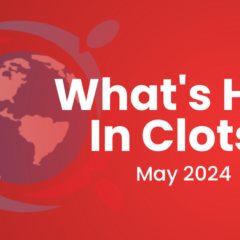Last updated on
Clot Chronicles: PAD Management
Hi, my name is Marc Bonaca. I’m a cardiologist and vascular medicine doctor. I’m presenting here on the Clot Chronicles about a recent randomized clinical trial called VOYAGER PAD. I want to tell you a little bit about this study and some of the key findings so far.
VOYAGER PAD was designed to address a big gap in the care of patients with peripheral artery disease (PAD), and that is how to best treat them in the setting of intervention. We know that patients with PAD are at a high risk of heart attack, stroke, and particularly, limb outcomes, and that that risk is particularly high after intervention.
That being said, the antithrombotic therapy that we use after peripheral artery intervention is not really demonstrated to be efficacious in trials. There have been trials of dual antiplatelet therapy (DAPT) with clopidogrel after surgical bypass, which have not shown efficacy and shown more bleeding. Warfarin has been studied both after bypass and in stable patients with PAD, and there’s an intolerable bleeding risk. And so, we don’t really know how to best treat these patients.
VOYAGER PAD was designed to be a pragmatic, very generalizable trial. It included patients with PAD who were undergoing intervention for symptoms. There is no further enrichment for risk of heart attack or stroke or limb outcomes. It was an unselected population. Obviously, patients that were at a very high bleeding risk were excluded either because of who they were—like prior stroke patients—or because they had to take other medicines like warfarin. But otherwise it was an all-comers approach.
Patients were treated with best background medical therapy; meaning they were supposed to be treated with statins. All patients received low-dose aspirin and patients received clopidogrel as well, which is really the standard of care. On top of the standard of care, patients were then randomized to either rivaroxaban 2.5 mg twice daily, the vascular protection dose, or a matching placebo and then followed for a median of 28 months – although there were many patients that were in the trial for more than 3 years.
Now, when thinking about VOYAGER, it’s really different than most cardiovascular outcomes trials. One because of the setting and population—there are very few trials in this space—but also because of the primary endpoint; it was really designed for this population, and it’s a composite of acute limb ischemia, major amputation of a vascular etiology, myocardial infarction (MI), ischemic stroke, or cardiovascular death. It’s the 5-point composite that really characterized the risks in this population.
So what did the trial show? Well first, who was included? I think this is really telling in terms of who we have in this population. It was a group of patients with pretty severe PAD; a quarter had chronic limb ischemia. The median ankle brachial index was about 0.56. And what’s interesting is despite many risk factors, only about a third or less had known coronary disease; only 11% had a prior MI. So this was a truly selected PAD population. Eighty percent got statins and half got clopidogrel, so treated according to the standard of care in most cases.
And so what did the trial show? Well the addition of rivaroxaban significantly reduced the primary endpoint with a relative risk reduction of 15% and a highly statistically significant result. But I think what’s more telling is that the curves separate very early – they’re apparent by 3 months; at 6 months, it’s statistically significant with the number needed to treat in the 60s and the curves continue to separate over time. And at 3 years, the number needed to treat is 39, which is quite low.
Now, we had a bunch of secondary outcomes, and those are all listed in the paper, and the first 5 of those were all positive. A couple to think about – unplanned index limb revascularization, which you’re really worried about in this population; that was significantly reduced with an absolute risk reduction about 2.5%. Event-free survival was reduced by more than 2.5%, and that was significant.
There was more bleeding. TIMI major bleeding was the primary safety or principle safety outcome; that’s because of the procedural setting. That type of bleeding definition has to be used. Rates were higher with rivaroxaban; the hazard ratio was about 1.43. There were actually just a difference of 18 bleeds between the 2 groups. But there was more bleeding with rivaroxaban, and I think that becomes more apparent when you look at more sensitive bleeding measures. And we reported BARC bleeding and ISTH bleeding. And you see similar hazard ratios as TIMI bleeding where the absolute increases are higher. How to think about bleeding? For TIMI major, it was about a quarter of 1% per year of an increase, and for ISTH it was about 0.6% per year.
How do you put all of this together? Well, with the overall this strategy in the population—whether it was a surgical or vascular approach, whether you used clopidogrel/you didn’t use clopidogrel—there was no effect modification; the benefit/risk was the same. Overall, treating 10,000 patients for a year, after an intervention with this strategy, reduced 181 ischemic irreversible harm events at a cost of 29 TIMI major bleeds but no excess in intracranial hemorrhage or fatal bleeding. So a 6:1 benefit-to-risk ratio – clearly beneficial. And again, there was consistency across all of the major subgroups.
So, you know, in an area where we haven’t had a lot of evidence, here is a therapy that, although it does increase bleeding, has an overall net benefit in the population for the outcomes that really matter to this population. And we don’t see any modification of the benefit with background clopidogrel; it works the same. Clopidogrel does increase bleeding, and so the conclusion of that analysis is to probably minimize exposure to clopidogrel where you can, especially given the lack of evidence in this space. But that is something, I think, that further analyses will have to hash out.
So, we believe that this trial demonstrates that rivaroxaban is an option for these patients. It builds on those observations from the COMPASS trial, which is a landmark trial of secondary prevention and polyvascular disease, including PAD, and showed big benefits for this strategy. And now we have a continuum of the patient with PAD coming in for intervention, you know, when to start it. It was a median of 5 days from randomization. What are the benefits over time and risks? And then for the patient that then transforms to a COMPASS patient, we also have data from that important trial.
Thanks for the opportunity to talk a little bit about VOYAGER PAD. I think there’s a lot to learn from this unique dataset, and we look forward to understanding more about the risks in this population and the benefits of low-dose rivaroxaban. Thank you.



